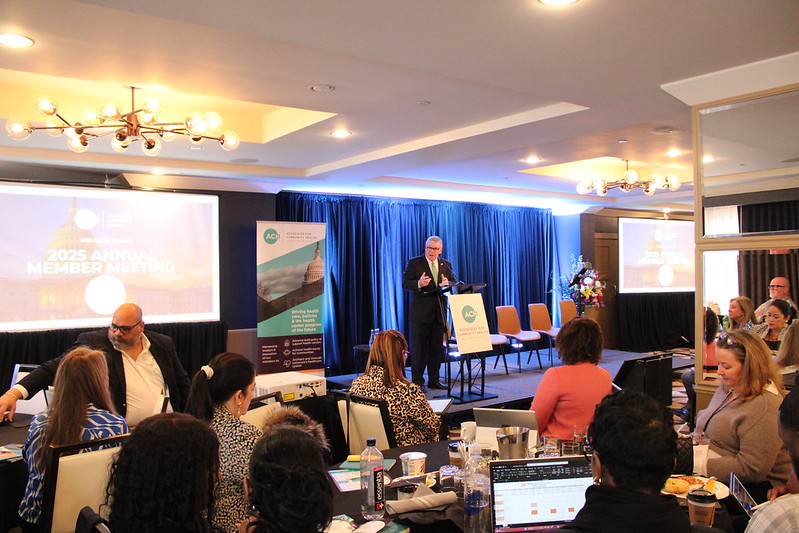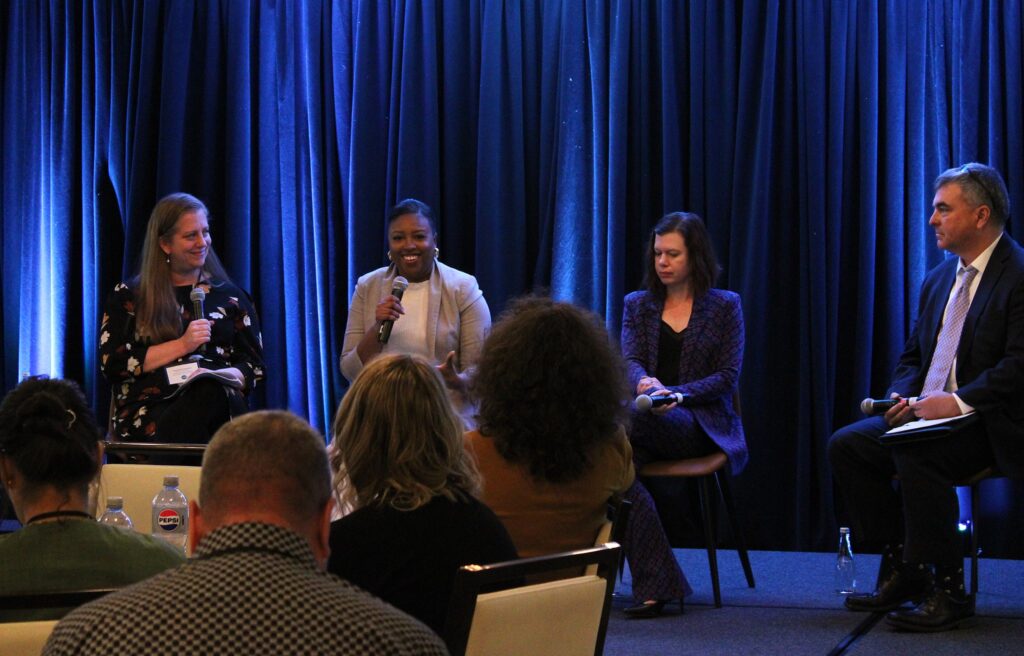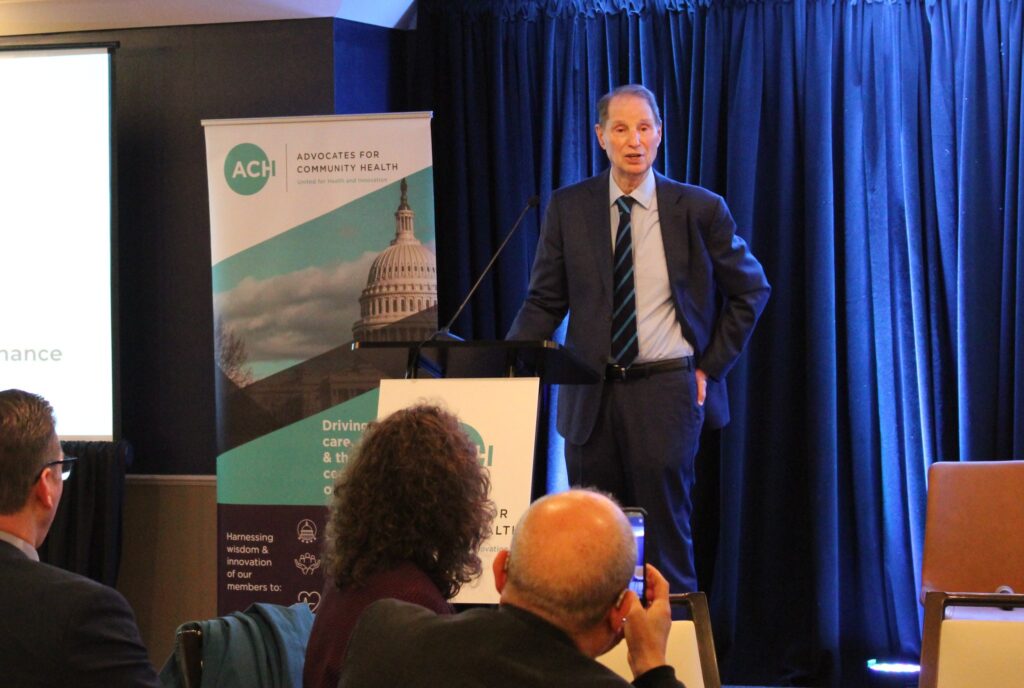Senior leaders from more than 30 of the nation’s largest federally qualified health centers (FQHCs) recently met in Washington, D.C., to discuss the future of the Health Center Program and advocate for reliable, long-term funding.
During the Advocates for Community Health (ACH) Annual Member Meeting on March 25-27,2025, health policy leaders shared their insights and reflected on the changes, challenges, and opportunities ahead.
Here are the top takeaways from the podium:
1. Now is the perfect time to be advocating on Capitol Hill for community health centers and the patients they serve.
Focusing on “opportunities” as the week’s key word, ACH’s CEO Amanda Pears Kelly said in her welcome remarks, “Health centers have a 60-year history of bipartisan support – that’s virtually unheard of in DC.” She urged attendees to encourage their members of Congress to have these conversations across the aisle.
Mat Lapinski, CEO of Crossroads Strategies, reminded ACH members that maintaining good relationships on both sides of the aisle is key because everyone needs to be prepared for a potential snapback in two years. “They may not agree on everything, but everyone can agree on the importance of economic success in the long run.”

“Your story is such a winning story,” said Margaret French, vice president at Venn Strategies, to members during the panel on Community Health Centers and the new Administration and Congress. “You are one of the most efficient ways to provide health care in the communities they represent,” added co-presenter Jason Van Pelt, executive vice president at Crossroads Strategies.
Several presenters emphasized the critical need to tell the health center story from an economic and human perspective. More than service hubs, health centers are economic engines, serving as major employers and injecting crucial dollars into local economies.
And behind every health center job and dollar, is a person, collectively caring for 32.5 million people each year. “Making sure patients are centric to the discussion will drive policy in the right way,” said Jennifer Dexter, vice president of policy at the National Health Council.
2. Health centers are the key to the Make America Healthy Again (MAHA) movement and the most efficient way for the new Administration to advance health care.
Americans continue to struggle to live healthy lives, and to make America Healthy Again and address these pressing challenges, the community health center (CHC) network is well-positioned to lead the way as a centerpiece of our country’s health care infrastructure.
“We often use the word ‘hero,’ and it’s overused at times, but in this case, and the services you provide all across this country, I know that those patients agree with me, you are heroes,” said keynote speaker Thomas J. Engels, administrator of the Health Resources and Services Administration (HRSA) at the Department of Health and Human Services. “Because without you, they would be traveling a long way, some of them would not be able to get the care that they need, and the care they’re getting is some of the best care in the country.”

On day two of the meeting, Associate Administrator for Primary Health Care at HRSA Jim Macrae said, “One way HRSA is already making an impact on the MAHA agenda is through HRSA’s Health Center Program—you!” He gave examples of how health centers are using food as medicine and nutrition counseling as ways to address chronic disease among their patients. Chronic disease prevention is a key issue for MAHA leadership, and reflects a strategic direction for more efficient and effective health policy.
“The Republican Party is talking about things in healthcare that they weren’t talking about five years ago,” said panelist Steven Voljavec, senior vice president at Crossroads Strategies.
“I have heard the term community health centers now on the Hill more than I ever have – that’s big,” said panelist Gabrielle Kalisz, program manager at Paragon Health Institute. “That’s what MAHA is about – it’s not about listening to the drug companies anymore – it’s about listening to people like you.”
3. As Medicaid is the largest revenue source for community health centers, Medicaid advocacy is a top focus not just for health centers, but for many advocacy groups because the impact of potential changes is cascading.
Protecting Medicaid for health center patients was a heavy focus for the week of advocacy on the Hill, as the House and the Senate currently have very different approaches to budget reconciliation, the process through which changes to Medicaid would be made. Senator Ron Wyden (D-OR), Ranking Member of the Senate Finance Committee, opened ACH’s Lobby Day by saying, “This is about whether you give a damn about people. Medicaid is a titanic battle we cannot lose…. And this is the challenge of our lifetime. We cannot afford to roll back the clock on health centers.”
Beth Feldpush, senior vice president of policy & advocacy at America’s Essential Hospitals, said during the panel on Medicaid in the 119th Congress that in her memory working in DC, this is the first time we’ve had two distinct plans on how Congress could proceed with a budget reconciliation bill.
She added, “We don’t know what the policies are yet, but in the House plan, they have asked the Energy & Commerce Committee to find $880 billion worth of savings. The reason why Medicaid advocates are so concerned is that if you zeroed out all of non-Medicaid or other programs under Energy & Commerce’s jurisdiction, that’s $275 billion, so there is no way for them to do this without cutting Medicaid.”
“Medicaid covers 40% of the births in this country, and about half of nursing home care, and everything in between,” said Craig Kennedy, CEO of Medicaid Health Plans of America. “We’re the largest payer for substance abuse disorder treatment in this country. There’s no one Medicaid person, it’s not a homogeneous population.”
How Medicaid is paid for is just as varied as the people served. Blaire Bryant, legislative director for health policy at the National Association of Counties shared that access to care is a key concern at the local level because when an uninsured individual comes to a county facility for care, that cost falls back on counties. “The fiscal impact is also a concern because Medicaid is a federal, state, and local partnership,” she said. “Counties have a responsibility to finance the non-federal share of Medicaid, and that number can be up to $7 billion a year in some areas like New York.”

“And lastly, we are concerned about workforce impacts, because this has a cascading impact on county government as a whole and economic activity.”
4. There is a need and an opportunity to share what community health centers do and how they benefit the community.
“Community health centers are, dollar for dollar, the best investment we can make in health care,” said Senator Wyden during his opening remarks on day three of the meeting.

Margaret French with Venn Strategies advised attendees not to assume that new members of Congress and staffers understand the Health Center Program. There may be an assumption that there is a lack of innovative things happening at health centers, and a lack of access to cutting-edge treatment.
“The innovation space is ripe, so make sure they know how you are using these digital tools so they can remove barriers or make it easier for you to use them,” she said. “They need to understand that you are already doing these things.”
Seema Alexander, co-founder of Virgent AI, underscored how CHCs are beginning to use AI and machine learning tools to improve efficiency, from note taking and transcription to medical billing and coding. “Something that took us hours, can now take us seconds,” she said.
5. Health centers can play a much greater role in the 340B Drug Discount Program.
Community health centers account for just 5.3% of the overall spending made in the 340B program in 2023, according to recent HRSA data. The 340B program is foundational to health centers, and many CHC leaders spoke of ensuring its protection. Health centers re-invest 340B savings into needed programs like chronic disease management and nutrition.
As this Administration and Congress are focused on the national debt and budget reconciliation, 340B may not be as much of a focus this year. However, Jason Van Pelt at Crossroads Strategies said, “Health centers can be honest brokers about how the 340B program can be assured.”
“You can be transparent about where the funding is being spent, and that’s exactly how the program is supposed to work.”
Additionally, Stephanie Krenrich, ACH senior vice president, Policy & Government Affairs, reminded members of the 340C legislative bridge proposal that could ensure the 340B program can continue to be a critical resource for health centers for years to come.
- Watch a video recap of ACH’s 2025 Annual Member Meeting
- View all photos of the 2025 Annual Member Meeting
- Contact ACH for more information